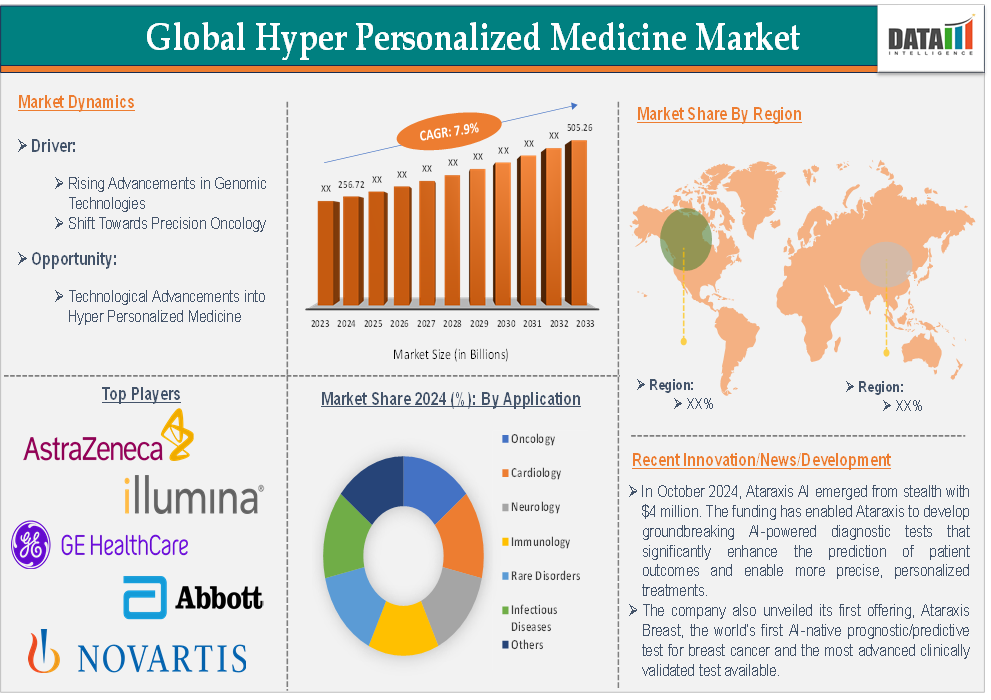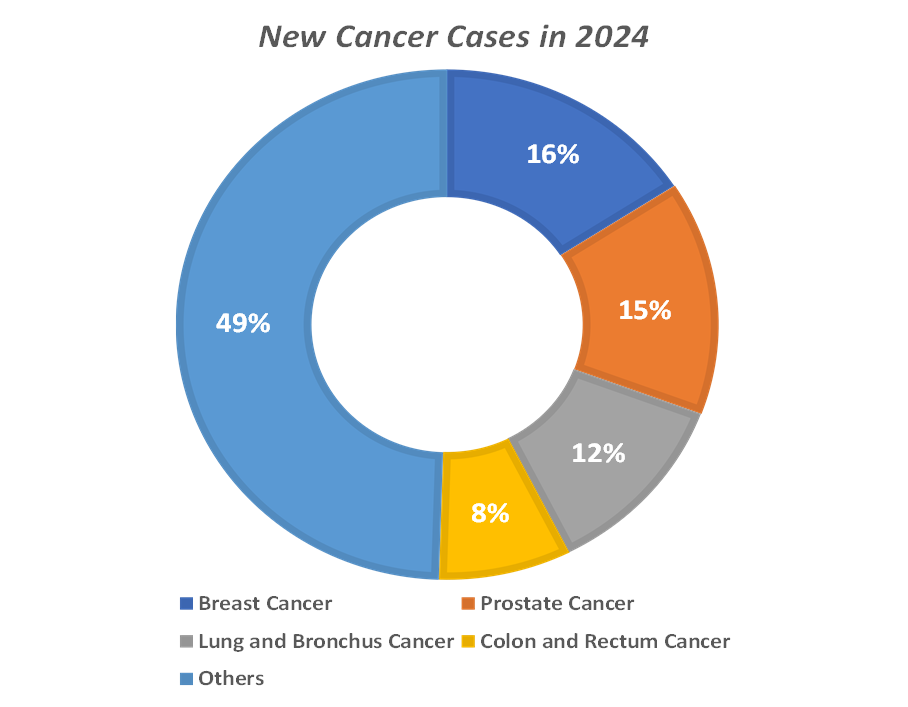Market Size
The Global Hyper Personalized Medicine Market reached US$ 256.72 billion in 2024 and is expected to reach US$ 505.26 billion by 2033, growing at a CAGR of 7.9% during the forecast period 2025-2033.
Hyper personalized medicine is an advanced healthcare approach that tailors medical treatment and preventive strategies to individual patients based on their unique biological, genetic, environmental and lifestyle factors. It goes beyond traditional medical practices by utilizing cutting-edge technologies like genomics, proteomics, metabolomics and bioinformatics to offer treatments that are highly specific to the molecular and cellular characteristics of each patient. This approach is revolutionizing healthcare by improving outcomes, reducing side effects and enabling preventive measures based on predictive insights.
The demand for hyper personalized medicine is rapidly expanding. For instance, according to the Personalized Medicine Coalition (PMC), With the approval of 17 new personalized medicines in 2021, personalized medicines, account for more than a quarter of the new drugs the agency has approved in, the past seven years. This figure represents a sharp increase. Just a decade ago, personalized medicines accounted for less than 10 percent of the new therapies approved each year. In Future, this market is set to transform healthcare delivery by integrating advanced technologies with precise, patient-centered care models, ensuring better outcomes and efficiency.
Executive Summary

For more details on this report – Request for Sample
Market Dynamics: Drivers & Restraints
Rising Advancements in Genomic Technologies
Rising advancements in genomic technologies are significantly driving the growth of the hyper personalized medicine market and are expected to drive the market over the forecast period. Technologies like Next-Generation Sequencing (NGS) have drastically reduced the cost and time needed for genome sequencing. According to the J. Craig Venter Institute, the cost of sequencing a human genome has dropped from over USD 100 million in 2001 to less than USD 1,000 today and takes only a few hours, making personalized medicine more accessible to a broader population.
Major market players are focussing on the development of hyper personalized medicine approaches, which further fueling the market growth. For instance, in March 2024, Nucleus Genomics, the next-generation genetic testing and analysis company, launched its DNA analysis product to bring the benefits of personalized medicine to everyone. Nucleus combined the power of whole-genome sequencing with innovative genomic analyses, ushering in a new era of personalized medicine for the public.
CRISPR gene-editing technology is enabling the development of personalized therapies by directly targeting the genetic causes of diseases. Companies are using CRISPR to explore treatments for genetic disorders such as sickle cell anemia and muscular dystrophy, offering highly personalized and potentially curative treatments.
For instance, in May 2024, Researchers at Columbia University College of Dental Medicine developed an exosome-based platform, "safeEXO-Cas," that significantly enhances the delivery of CRISPR/Cas9 genome editing components to specific cells and tissues. The potential of this innovative platform is to revolutionize gene therapy and precision medicine.
Complexity of Data Integration
The complexity of data integration is expected to hamper the growth of the hyper personalized medicine market. This issue primarily arises from the integration of vast and varied datasets, which include genomic, proteomic, clinical and environmental data. These challenges impact the ability to efficiently develop personalized treatment plans, slowing the adoption of hyper personalized medicine.
Personalized medicine requires the integration of large-scale data from different sources like electronic health records (EHRs), genomic sequencing, medical imaging and real-time monitoring devices. These data types are often siloed across systems and lack standardization, making it difficult to draw comprehensive insights. For instance, genomic data might be stored in one system, while clinical data is in another, and patient health records are stored in yet another platform. This lack of uniformity complicates the creation of a cohesive, actionable profile for individual patients.
Healthcare systems across different regions often use incompatible technologies, leading to poor interoperability between electronic health systems. For instance, a report by the American Health Information Management Association (AHIMA) indicates that 80% of healthcare organizations in the US experience data integration issues, which directly affects the efficiency of personalized treatments.
Market Segment Analysis
The global hyper personalized medicine market is segmented based on product type, technology, application and region.
Application:
The oncology from application segment is expected to dominate the hyper personalized medicine market
Cancer is one of the most prevalent diseases worldwide. The increasing prevalence directly increases the demand for effective treatments, particularly in the face of diverse tumor types, this has accelerated the shift toward personalized oncology. This hyper personalized approaches in oncology allow for targeting specific mutations in tumors, offering better outcomes and reducing side effects compared to traditional treatments.
For instance, according to the National Institute of Health, cancer is among the leading causes of death worldwide. In 2022, there were almost 20 million new cases and 9.7 million cancer-related deaths worldwide. By 2040, the number of new cancer cases per year is expected to rise to 29.9 million and the number of cancer-related deaths to 15.3 million. According to the International Agency for Research on Cancer, in 2025, cancer incidence cases are projected to reach 21.3 million, and in 2030, the cases are estimated to reach 24.1 million.

The use of genomic profiling in oncology allows for identifying genetic mutations that drive cancer progression, enabling more accurate diagnoses and targeted treatments. Technologies like Next-Generation Sequencing (NGS) are extensively used to analyze tumor genomes. For instance, FoundationOne by Foundation Medicine offers comprehensive genomic profiling of solid tumors to identify actionable mutations, guiding the selection of targeted therapies.
Market Geographical Analysis
North America is expected to hold a significant position in the hyper personalized medicine market
North America, particularly the United States is a global leader in biomedical research, accounting for approximately 60% of the world's total healthcare R&D spending. Significant funding is provided for the development of precision medicine technologies, including genomic profiling, bioinformatics and digital health solutions.
North America benefits from a robust regulatory environment, particularly through organizations like the FDA (Food and Drug Administration) in the United States. The FDA has approved several personalized therapies such as CAR-T cell treatments such as Kymriah for leukemia and checkpoint inhibitors such as Keytruda for various cancers. These approvals drive market growth by providing a clear pathway for the development and commercialization of hyper personalized medicines.
North America leads the adoption of advanced technologies like artificial intelligence (AI), which are pivotal in the development of personalized medicine. For instance, in October 2024, Ataraxis AI emerged from stealth with $4 million. The funding has enabled Ataraxis to develop groundbreaking AI-powered diagnostic tests that significantly enhance the prediction of patient outcomes and enable more precise, personalized treatments. The company also unveiled its first offering, Ataraxis Breast, the world’s first AI-native prognostic/predictive test for breast cancer and the most advanced clinically validated test available.
Major Global Players
The major global players in the hyper personalized medicine market are AstraZeneca PLC, GE HealthCare, Illumina, Inc., Novartis AG, Precision Biologics., Abbott Laboratories, ASURAGEN, INC., F. Hoffmann-La Roche Ltd., Achilles Therapeutics plc, QIAGEN N.V. and among others.
Market Scope
| Metrics | Details | |
| CAGR | 7.9% | |
| Market Size Available for Years | 2022-2033 | |
| Estimation Forecast Period | 2025-2033 | |
| Revenue Units | Value (US$ Bn) | |
| Segments Covered | Product Type | Therapeutics, Diagnostics and Software Solutions |
| Technology | Genomics, Proteomics, Bioinformatics, Artificial Intelligence (AI) and Others | |
| Application | Oncology, Cardiology, Neurology, Immunology, Rare Disorders, Infectious Diseases and Others | |
| Regions Covered | North America, Europe, Asia-Pacific, Latin America, and Middle East & Africa | |
Why Purchase the Report?
- Pipeline & Innovations: Reviews ongoing clinical trials, product pipelines, and forecasts upcoming advancements in medical devices and pharmaceuticals.
- Product Performance & Market Positioning: Analyzes product performance, market positioning, and growth potential to optimize strategies.
- Real-World Evidence: Integrates patient feedback and data into product development for improved outcomes.
- Physician Preferences & Health System Impact: Examines healthcare provider behaviors and the impact of health system mergers on adoption strategies.
- Market Updates & Industry Changes: Covers recent regulatory changes, new policies, and emerging technologies.
- Competitive Strategies: Analyzes competitor strategies, market share, and emerging players.
- Pricing & Market Access: Reviews pricing models, reimbursement trends, and market access strategies.
- Market Entry & Expansion: Identifies optimal strategies for entering new markets and partnerships.
- Regional Growth & Investment: Highlights high-growth regions and investment opportunities.
- Supply Chain Optimization: Assesses supply chain risks and distribution strategies for efficient product delivery.
- Sustainability & Regulatory Impact: Focuses on eco-friendly practices and evolving regulations in healthcare.
- Post-market Surveillance: Uses post-market data to enhance product safety and access.
- Pharmacoeconomics & Value-Based Pricing: Analyzes the shift to value-based pricing and data-driven decision-making in R&D.
The global hyper personalized medicine market report delivers a detailed analysis with 62 key tables, more than 58 visually impactful figures and 159 pages of expert insights, providing a complete view of the market landscape.
Target Audience 2024
- Manufacturers: Pharmaceutical, Medical Device, Biotech Companies, Contract Manufacturers, Distributors, Hospitals.
- Regulatory & Policy: Compliance Officers, Government, Health Economists, Market Access Specialists.
- Technology & Innovation: AI/Robotics Providers, R&D Professionals, Clinical Trial Managers, Pharmacovigilance Experts.
- Investors: Healthcare Investors, Venture Fund Investors, Pharma Marketing & Sales.
- Consulting & Advisory: Healthcare Consultants, Industry Associations, Analysts.
- Supply Chain: Distribution and Supply Chain Managers.
- Consumers & Advocacy: Patients, Advocacy Groups, Insurance Companies.
- Academic & Research: Academic Institutions.

